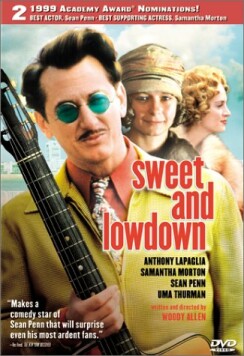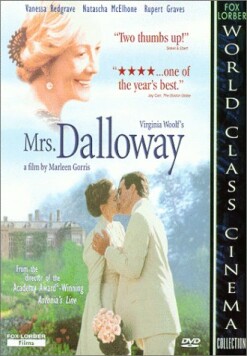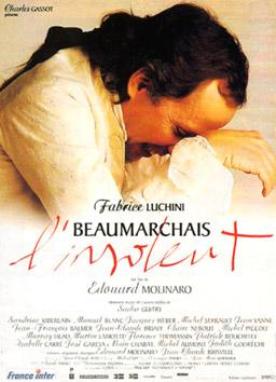Sweet and Lowdown
Woody Allen’s Sweet and Lowdown could be said to be a loving, autumnal tribute to the two great passions of its director’s life
outside of the cinema, namely, jazz and psychotherapy. True, the movie contains no scenes
involving therapy, nor even any reference to it, but its subtext is the
fundamental therapeutic assumption of vulgar Freudianism, at least as it has emerged in the popular
culture of America at the turn of the century: never suppress (or, as it is
usually rendered, “repress”) your feelings.
Set in the 1930s, the film takes the form of a mock documentary about the
life of a fictional jazzman of the period, a guitarist called Emmet Ray (Sean
Penn). A running in-joke has Ray so admiring and at the same time so jealous of
the great (real) jazz guitarist, Django Reinhardt, that he faints on the one
occasion when they met. He, Ray, is generally considered the second-greatest
jazz guitarist in the world, but “Nate Drummond preferred me.” Thereafter he
goes around saying “On guitar, no one can touch me. Except for this gypsy in
France. But mostly I’m untouchable” or “Some people think I’m the greatest
guitar player who ever lived…There’s this gypsy in France.” Ray’s colorful
life in the happily mixed-race, quasi-underground world of small bars and clubs
when jazz was still authentic and rather disreputable obviously appeals to Mr.
Allen’s sense of romance.
The common ground of jazz and therapy is that both involve giving free rein
to one’s emotional individuality — though in therapy it is easier to go
beyond the point at which emotion ceases to be individual or interesting and
becomes merely a common human property, for instance in feelings of
“insecurity.” Emmet Ray seems to have few of these. When one of his many
girlfriends tells him that he can’t let his feelings out and therefore can’t
truly care for anyone else, he replies with genuine bewilderment: “You say that
like it’s something bad.” To another girlfriend, the redoubtable Blanche (Uma
Thurman) he states the same view as a general principle: “If you let your
insides out, you’re finished.”
Apart from sex, his two favorite things to do with his girlfriends is to go
shooting rats at the dump and to watch trains. True, some of them are put off by
this (“Shootin’ rats at the dump is not my idea of a good time”), but one of the
advantages of living in the 1930s seems to have been that women were more
compliant about things like that. Blanche, who fancies herself a writer
positively enjoys it for the insight it gives her into Emmet: “Do you get a
bigger kick doing this [i.e. shooting rats] or stealing small objects,” she asks him. She is an early Freudian and
expresses her interest in Ray by saying that he “has a violent side but it all
turns to passion in his music” where there is “no sublimation.” To Ray himself
she says, a little improbably: “With you I feel like I’m looking into the Heart
of Darkness.”
But soon her professional interest is piqued by another Heart of Darkness and
she runs off with a gangster called Al Torrey (Anthony La Paglia) who also gets
her sympathetic ear. “Everybody I ever rubbed out deserved it,” he confides in
Blanche.
“That’s so colorful,” she replies. “And what do you think of when you’re
rubbing someone out?”
In the end it doesn’t matter. The love of Emmet Ray’s life turns out to have
been the mute laundress, Hattie (Samantha Morton), whom he meets at an amusement
park in New Jersey and who puts up — mutely, of course — with his
appalling ill treatment until he dumps her for Blanche. She returns to her
laundry and marries someone else. When Ray comes back for her and finds her
already taken, he has no words to express his feelings, or scarcely any
realization that he has feelings. But nothing is ever the same for him
afterwards, and the story ends with the pseudo-documentarian announcing that the
second-greatest jazz guitarist in the world seems to have just “faded away.”
Woody Allen knows that jazzmen in the 1930s were, like everybody else in the
1930s, much less given to talking about their feelings than we are today, but in
the end I think he’s not entirely sure what he thinks of the fact. On the one
hand, the emotional reticence of someone like Emmet Ray is shown as having
wrecked his life and, ultimately, even his art. The last we see of him he is
smashing his guitar in a fit of anger. On the other hand, reserving one’s
interior life for the music may have been what made the dear dead world of 1930s
jazz what it was. Besides, the idea of having a devoted and uncomplaining mute
as a female companion obviously appeals to him too. Could there be just a touch
of self-mockery here? Insofar as you can believe that, you will find this film
worth seeing.
Discover more from James Bowman
Subscribe to get the latest posts to your email.








